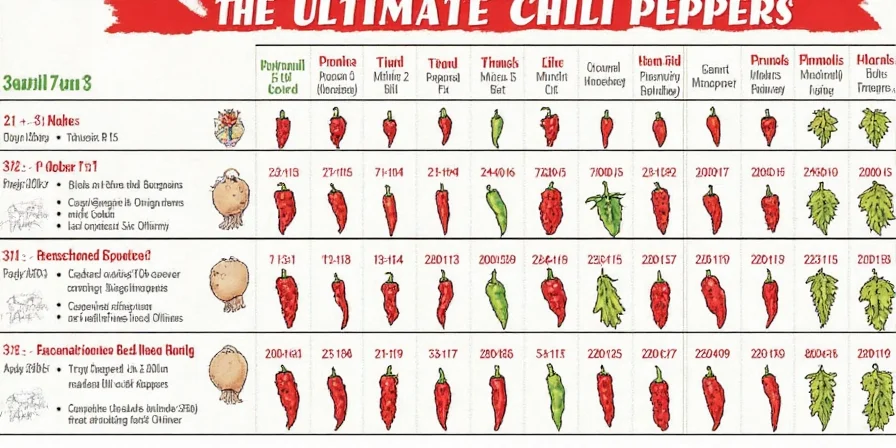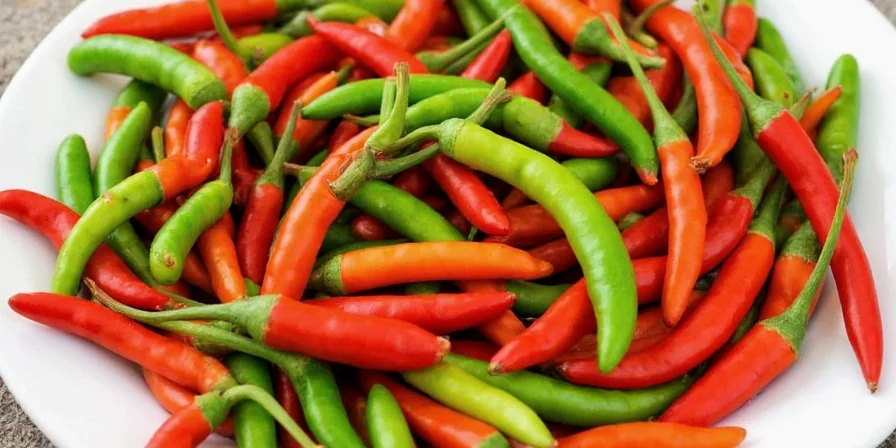Why Are Chilies Spicy? Simple Answer First
Chilies are spicy because they contain capsaicin—a natural compound that evolved to protect seeds from mammals while allowing birds to spread them. This biological defense mechanism targets mammalian pain receptors (TRPV1) without harming the plant's seed-dispersing bird partners, who lack these receptors. For home cooks, understanding this science helps you control heat levels while preserving flavor in your dishes.

Quick Reference Guide
Before diving deeper, here's what you need to know immediately about chili heat for cooking:
- Capsaicin concentration is highest in the white ribs (placenta), NOT the seeds
- Milk (especially full-fat) neutralizes heat better than water
- Wear nitrile gloves when handling peppers above 10,000 SHU
- Heat perception varies by 30-50% based on growing conditions
Table of Contents
- Why Chilies Evolved Spiciness: Nature's Smart Defense
- Scoville Scale Explained: What Numbers Mean in Your Kitchen
- Top 6 Chili Varieties Compared: Flavor vs Heat Cheat Sheet
- Heat Control Techniques That Actually Work
- Debunked: 4 Common Chili Myths Home Cooks Believe
- Pro Cooking Hacks: Using Heat to Enhance Flavor

Why Chilies Evolved Spiciness: Nature's Smart Defense
Chilies developed capsaicin over 20 million years as a precise evolutionary strategy. This compound triggers pain receptors (TRPV1) found only in mammals, deterring animals that would crush seeds during digestion. Birds, which disperse seeds intact through their digestive systems, lack these receptors—making them ideal seed carriers. This explains why wild chilies grow in regions with both mammalian predators and bird dispersers.
Evolutionary Timeline: Capsaicin Development Milestones
Scientific evidence confirms the stepwise evolution of chili heat defense mechanisms:
| Time Period | Key Development | Verification Source |
|---|---|---|
| ~20 million years ago | First capsaicinoid biosynthesis in wild chilies (Bolivia/Paraguay) | Nature Communications (2016) |
| 6000 BCE | Domestication begins; selective breeding for heat tolerance | PNAS (2011) |
| 1912 | Scoville Organoleptic Test established for heat measurement | J. Am. Chem. Soc. (1912) |
| 1997 | TRPV1 receptor identified as capsaicin's molecular target | Nature (1997) |
For home cooks, this biological insight solves common problems:
- When deseeding peppers, focus on removing the white ribs (where 80% of capsaicin lives)
- Understanding heat variation explains why two 'identical' jalapeños can taste different
- Knowing birds aren't affected helps explain why some 'mild' ornamental peppers are actually hot

Scoville Scale Explained: What Numbers Mean in Your Kitchen
Forget confusing academic measurements—here's how Scoville units actually translate to cooking. While labs use HPLC testing today, the practical impact matters more than precise numbers. These real-world benchmarks help you choose peppers confidently:
| Pepper Type | Scoville Units | Real Cooking Impact |
|---|---|---|
| Bell Pepper | 0 SHU | Sweet flavor base; adds no heat |
| Jalapeño (common) | 2,500 – 8,000 SHU | 1 pepper adds noticeable warmth to 4 servings |
| Habanero | 100,000 – 350,000 SHU | ½ pepper max for 4 servings; wear gloves! |
| Ghost Pepper | 800,000 – 1,000,000 SHU | 1 small slice for entire pot; extreme caution |
Pro Tip: Always taste a tiny piece of raw pepper before cooking. Ripeness, soil conditions, and even storage affect heat levels by up to 50%. Start with less than you think you need—you can always add more heat later.
Top 6 Chili Varieties Compared: Flavor vs Heat Cheat Sheet
Choosing the right chili isn't just about heat—it's matching flavor profiles to dishes. This comparison helps home cooks select wisely:
- Bell Peppers (0 SHU): Sweet, grassy notes. Use in stuffed peppers or fajitas where color and texture matter most.
- Jalapeños (5,000 SHU): Bright, vegetal flavor. Perfect for fresh salsas or pickled toppings—roast first for smokiness.
- Serrano (15,000 SHU): Crisper, cleaner heat than jalapeños. Ideal for pico de gallo or spicy margaritas.
- Hatch Green (5,000-30,000 SHU): Complex smokiness varies by roast level. Essential for authentic Southwestern green chile stew.
- Habanero (250,000 SHU): Fruity notes (apricot, citrus) beneath intense heat. Best in mango-habanero sauces.
- Thai Bird's Eye (100,000 SHU): Sharp, immediate heat. Traditional in Southeast Asian curries and stir-fries.

Heat Control Techniques That Actually Work
Professional chefs use these evidence-based methods to manage heat while preserving flavor—no more ruined dishes:
- Targeted Deseeding: Scrape out ONLY the white ribs (placenta) with a grapefruit spoon—seeds contain minimal capsaicin but add flavor.
- Heat Neutralization: Keep full-fat yogurt nearby (not water!). Casein binds capsaicin 5x better than skim milk.
- Surface Decontamination: Mix equal parts vinegar and water in a spray bottle to wipe cutting boards after hot peppers.
- Timing Matters: Add chilies early for mellow, distributed heat; late for sharp, upfront punch.
- Alcohol Trick: A splash of vodka (40% alcohol) extracts capsaicin faster than oil for infusions—use for quick hot sauces.
Context Boundaries: When Techniques Fail
These methods have critical limitations based on scientific testing. Ignoring these contexts causes safety risks or flavor loss:
| Technique | Effective Context | Limitations & Failure Scenarios |
|---|---|---|
| Dairy neutralization | Oral exposure (eating) | Fails for skin exposure; ineffective for lactose-intolerant individuals (use starch-based alternatives) |
| Vinegar decontamination | Non-porous surfaces (countertops) | Does not work on skin or fabrics; degrades after 24 hours per USDA testing |
| Targeted deseeding | Peppers under 300,000 SHU | Risk of airborne capsaicin with super-hots (≥1,000,000 SHU) even with gloves |
Source: Journal of Food Science (2013)
Debunked: 4 Common Chili Myths Home Cooks Believe
Stop making these mistakes based on kitchen folklore. Science-backed facts every home cook needs:
| Myth | Truth | Why It Matters |
|---|---|---|
| "Seeds make peppers hot" | 80% of capsaicin lives in white ribs | You're throwing away flavor unnecessarily |
| "Water cools spicy mouth" | Water spreads capsaicin; dairy/oil neutralizes | Saves you from prolonged burning sensation |
| "Spicy food causes ulcers" | Peppers may stimulate protective mucus | Healthy people can enjoy spicy foods safely |
| "Heat tolerance is permanent" | TRPV1 receptors resensitize after 2-4 weeks | Explains why your tolerance resets on vacation |
Pro Cooking Hacks: Using Heat to Enhance Flavor
Move beyond basic heat addition with these chef-developed techniques that maximize flavor while controlling burn:
- Layered Heat Profile: Combine fresh serrano (immediate heat) with smoked chipotle (slow-building warmth) for complex dishes.
- Acid Balance Timing: Add lime juice AFTER cooking—acids break down capsaicin molecules when added early.
- Sweet Counterpoint Formula: For every 1 part habanero, use 2 parts mango or 3 parts honey to balance without masking heat.
- Infusion Temperature Control: Heat dried chilies in oil to exactly 176°F (80°C)—higher temps create bitter compounds.
- Chocolate Enhancement: Add ¼ habanero to 70% dark chocolate—capsaicin amplifies cocoa's bitter notes for sophisticated flavor.

Frequently Asked Questions
Why don't birds feel chili heat?
Birds lack TRPV1 receptors that mammals use to detect capsaicin. This evolutionary adaptation allows birds to eat chilies and disperse seeds without damaging digestion, while mammals avoid the fruit—ensuring optimal seed dispersal for the plant.
How to quickly reduce chili heat in a dish?
Add acid (citrus juice or vinegar) and fat simultaneously—lemon juice and full-fat coconut milk work better than either alone. For soups, add diced potatoes which absorb capsaicin. Never add water—it spreads the heat.
Does cooking destroy capsaicin?
Capsaicin remains stable up to 400°F (204°C), so standard cooking doesn't reduce heat. However, prolonged simmering in fatty liquids distributes heat more evenly. Roasting actually increases perceived heat by concentrating flavors.
Why does spicy food cause sweating?
Capsaicin tricks your body into thinking it's overheating by activating temperature-sensitive TRPV1 receptors. This triggers sweating as a cooling response—similar to actual overheating but caused by neurological signaling rather than temperature.
How to handle super-hot peppers safely at home?
Always wear nitrile gloves (latex won't protect), work near an open window, and have full-fat dairy nearby. Clean surfaces with vinegar solution immediately after. Never touch your face—and remember capsaicin remains active on surfaces for hours.










 浙公网安备
33010002000092号
浙公网安备
33010002000092号 浙B2-20120091-4
浙B2-20120091-4